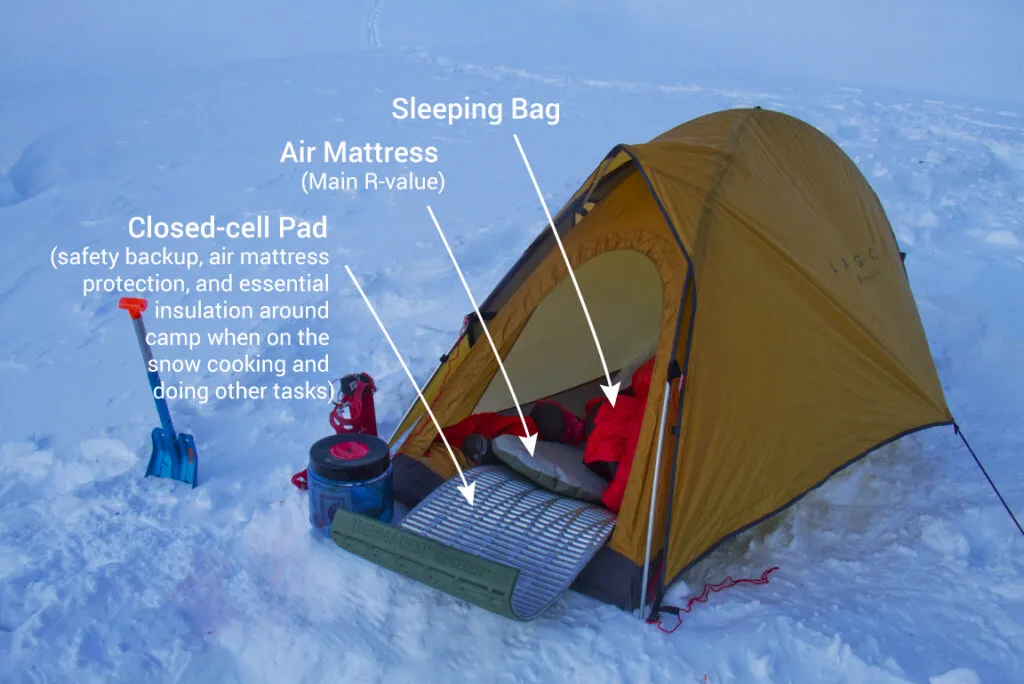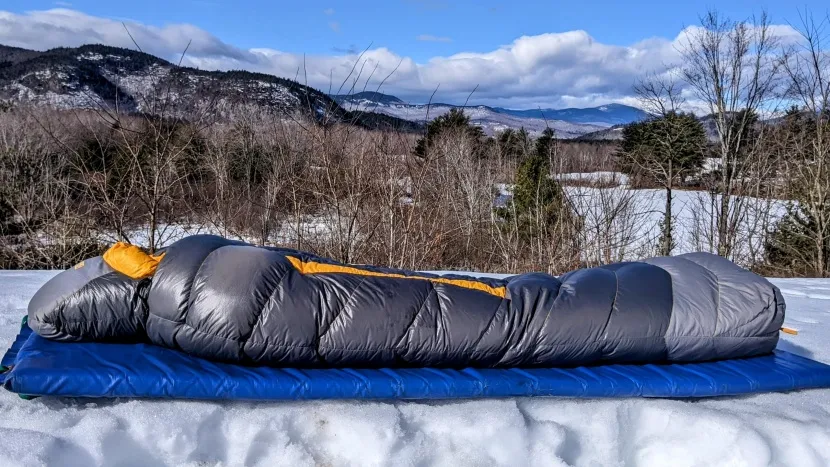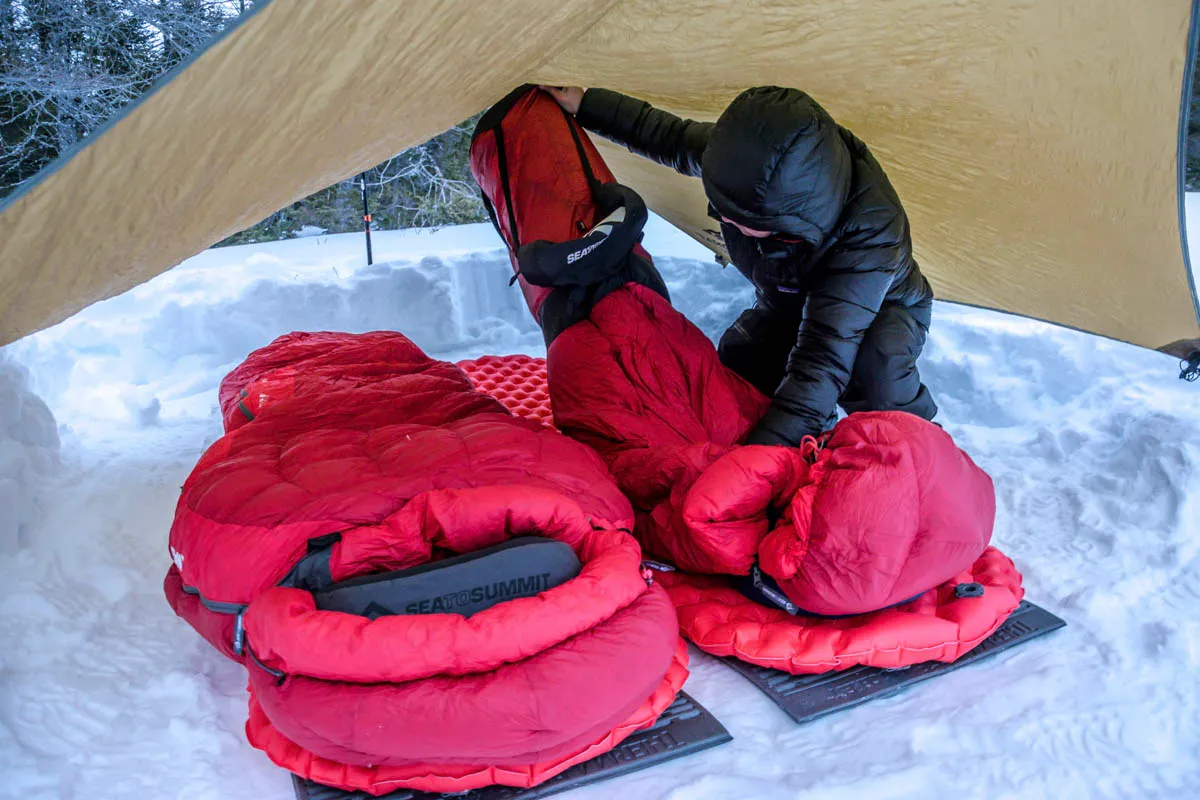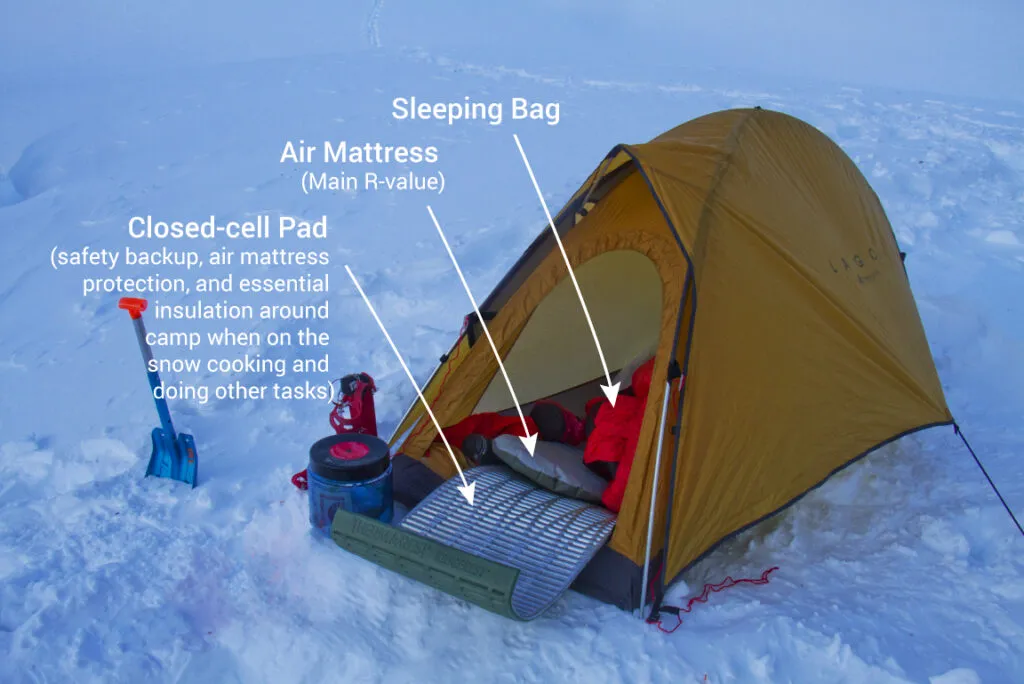When temperatures plummet below freezing, having the right sleeping bag can mean the difference between a comfortable night's sleep and a potentially dangerous situation. After spending countless nights in sub-zero conditions across Alaska, the Canadian Rockies, and Minnesota's Boundary Waters, I've learned that investing in quality sleeping bags for sub zero temperatures is not just about comfort—it's about survival.
Visit our homepage at NatureGuests.com for more outdoor gear reviews and wilderness adventure guides.
Why Sub Zero Sleeping Bags Matter

The human body loses heat rapidly in sub-zero conditions, and hypothermia can set in within hours if you're not properly equipped. Traditional sleeping bags rated for mild temperatures simply cannot provide adequate protection when the mercury drops below 0°F (-18°C). This is where specialized sleeping bags for sub zero temperatures become essential survival gear.
During my decade of winter camping across North America, I've witnessed firsthand how the right sleeping bag can transform a miserable, potentially dangerous experience into an enjoyable outdoor adventure. The difference between a quality sub-zero bag and a standard three-season bag is dramatic—not just in warmth, but in moisture management, durability, and overall construction.
Modern sleeping bags for sub zero temperatures incorporate advanced insulation technologies, sophisticated baffle designs, and weather-resistant materials that work together to create a protective cocoon. These bags are engineered to handle not just extreme cold, but also the condensation issues that plague winter camping, ensuring you stay dry and warm throughout the night.
The investment in a quality sub-zero sleeping bag pays dividends in safety, comfort, and peace of mind. Whether you're planning a winter backpacking trip, ice fishing expedition, or emergency preparedness, having the right sleeping bag can literally be a lifesaver. For those interested in lightweight sleeping bags for winter camping, the modern options balance warmth with packability better than ever before.
My Experience with Extreme Cold Camping
Lessons from the Boundary Waters
My most memorable lesson about the importance of quality sleeping bags for sub zero temperatures came during a February trip to Minnesota's Boundary Waters Canoe Area. The temperature dropped to -22°F (-30°C), and I was testing a budget "0-degree" bag that proved woefully inadequate.
That night taught me that temperature ratings can be misleading, and that investing in a proven system is crucial for safety. I ended up layering every piece of clothing I had inside that bag and still barely made it through the night.
Since that eye-opening experience, I've tested dozens of sleeping bags in conditions ranging from -40°F in Alaska to -15°F in the Canadian Rockies. Each trip has reinforced the importance of understanding not just temperature ratings, but how factors like humidity, wind, and personal metabolism affect warmth retention.
One of my most successful sub-zero camping experiences was with a Western Mountaineering Kodiak during a January expedition in Denali National Park. The bag's 850-fill down and generous cut kept me comfortable at -30°F, demonstrating the difference that quality insulation and design make. The ranger I spoke with confirmed that proper sleeping systems are the most common gear failure point he sees in winter rescue situations.
Over the years, I've learned that sleeping bags for sub zero temperatures require specific care and maintenance. Down insulation needs regular fluffing and proper storage, while synthetic fills offer better performance when damp but are typically heavier. Understanding these trade-offs has helped me select the right bag for each specific adventure.
The evolution of sub-zero sleeping bag technology has been remarkable. Modern bags like the ultralight winter sleeping bags now offer warmth-to-weight ratios that seemed impossible just a decade ago. This progress has opened up new possibilities for winter backpacking and mountaineering.
Top 5 Best Sleeping Bags for Sub Zero Temperatures
1. Marmot CWM -40°F Sleeping Bag

The Marmot CWM (Cold Weather Mountaineering) represents the pinnacle of sleeping bags for sub zero temperatures. With an EN Lower Limit rating of -40°F, this bag is designed for the most extreme conditions on Earth.
Key Features:
- 800-fill power down insulation
- Pertex Quantum GL outer shell
- Full-length two-way zipper
- Dual side zippers for arm access
- Weight: 5 lbs (Regular)
2. Western Mountaineering Kodiak 0°F
A favorite among serious winter campers, the Western Mountaineering Kodiak offers exceptional warmth-to-weight ratio and is consistently rated among the best sleeping bags for sub zero temperatures by outdoor professionals.
Key Features:
- 850+ fill power down
- Generous cut for layering
- Continuous baffles prevent cold spots
- Superior moisture management
- Weight: 2.8 lbs (Regular)
3. Nemo Sonic 0°F Down Sleeping Bag
The Nemo Sonic stands out among sleeping bags for sub zero temperatures for its innovative temperature regulation system and comfortable spoon shape that accommodates side sleepers.
Key Features:
- 800-fill power hydrophobic down
- Thermo Gills ventilation system
- Spoon shape for side sleeping
- Waterproof footbox
- Weight: 3.4 lbs (Regular)
4. Therm-a-Rest Polar Ranger -20°F
Developed with polar explorer Eric Larsen, this bag represents cutting-edge design in sleeping bags for sub zero temperatures, featuring a unique center-zip design for expedition use.
Key Features:
- 800-fill power hydrophobic down
- Center-zip design with side vents
- Snorkel hood system
- Removable sleeping pad straps
- Weight: 3.25 lbs (Regular)
5. Coleman North Rim 0°F Big & Tall
For budget-conscious campers seeking reliable sleeping bags for sub zero temperatures, the Coleman North Rim offers solid performance at an accessible price point.
Key Features:
- Synthetic insulation
- Big and tall sizing
- No-snag zipper
- Adjustable hood
- Weight: 4.2 lbs
When selecting from these top-tier sleeping bags for sub zero temperatures, consider your specific needs. For expedition use, the Marmot CWM and Therm-a-Rest Polar Ranger excel. For versatile winter camping, the Western Mountaineering Kodiak and Nemo Sonic offer excellent performance. Budget-conscious buyers will find solid value in the Coleman North Rim.
Each of these bags represents a different approach to sub-zero camping comfort. The key is matching the bag's design philosophy to your intended use. Those interested in lightweight down sleeping bags for winter will gravitate toward the Western Mountaineering option, while those prioritizing durability might choose the Marmot CWM.
Ultimate Buying Guide

Understanding Temperature Ratings
When shopping for sleeping bags for sub zero temperatures, understanding temperature ratings is crucial. The EN (European Norm) rating system provides three key temperatures: Comfort, Lower Limit, and Extreme. The Comfort rating represents the temperature at which a standard woman remains comfortable, while the Lower Limit is where a standard man can maintain warmth. The Extreme rating indicates survival conditions only.
For true sub-zero camping, I recommend choosing a bag rated at least 10-15 degrees below your expected conditions. This buffer accounts for individual variation, aging of insulation, and environmental factors like humidity and wind that affect perceived temperature.
Down vs. Synthetic Insulation
The choice between down and synthetic insulation in sleeping bags for sub zero temperatures involves several trade-offs. Down insulation offers superior warmth-to-weight ratio and compressibility, making it ideal for backpacking. However, down loses insulating properties when wet and requires more maintenance.
Synthetic insulation maintains warmth when damp, dries faster, and costs less. However, it's heavier and bulkier than down. For most sub-zero applications, high-quality down with hydrophobic treatment offers the best performance, especially when paired with proper moisture management techniques.
Bag Shape and Features
Mummy bags offer the best warmth-to-weight ratio by minimizing air space, but some campers find them restrictive. Rectangular bags provide more room but require more energy to heat. Many modern sleeping bags for sub zero temperatures use a modified mummy design that balances warmth and comfort.
Essential features for sub-zero bags include draft tubes along zippers, adjustable hoods, and shoulder baffles. Advanced features like foot vents, arm zippers, and snorkel hoods can significantly improve comfort in extreme conditions. Those exploring compact winter sleeping bags should prioritize compression ratings alongside warmth specifications.
Shell Materials and Durability
The shell material of sleeping bags for sub zero temperatures must balance weight, durability, and weather resistance. Pertex Quantum and similar fabrics offer excellent performance, while heavier ripstop nylons provide better puncture resistance for expedition use.
DWR (Durable Water Repellent) treatments are essential for managing condensation and light precipitation. Look for bags with reinforced areas at stress points and consider the intended use environment when evaluating shell durability needs.
Pro Tip
Always test your sleeping bag system in controlled conditions before venturing into extreme cold. Practice with the same clothing layers, sleeping pad, and shelter you'll use in the field. This preparation can identify potential issues before they become dangerous.
Real User Reviews and Testing
Amazon User Review - Marmot CWM
"Used this bag on a February trip to Alaska where temps hit -35°F. The bag performed flawlessly - stayed warm all night without overheating. The side zippers are genius for middle-of-the-night tasks. Yes, it's expensive, but it's literally life-saving gear."
- Verified Purchase, 5/5 stars
Reddit User Experience - Western Mountaineering Kodiak
"I've been using the Kodiak for three winters now, including nights down to -25°F. The bag's generous cut lets me sleep comfortably with all my gear inside. The continuous baffles eliminate cold spots completely. Best investment I've made for winter camping."
- r/CampingGear, 152 upvotes
Quora Expert Opinion - Nemo Sonic
"As a wilderness guide, I've tested dozens of sleeping bags. The Nemo Sonic's ThermGills are a game-changer for temperature regulation. Used it successfully in Yellowstone at -15°F. The spoon shape works well for side sleepers who normally struggle with mummy bags."
- Wilderness Guide, 10+ years experience
These real-world testimonials highlight the importance of field-testing sleeping bags for sub zero temperatures in actual extreme conditions. Professional guides and experienced winter campers consistently emphasize that these bags perform as advertised when properly used within their design parameters.
Common themes across user reviews include the importance of proper sizing, the value of premium down insulation, and the need for adequate sleeping pad insulation. Many users report that investing in quality sleeping bags for sub zero temperatures transforms their winter camping experience from endurance to enjoyment.
Negative reviews typically relate to mismatched expectations, inadequate understanding of temperature ratings, or insufficient supporting gear like sleeping pads. This reinforces the importance of viewing the sleeping bag as part of a complete system rather than a standalone solution. For those researching backpacking sleeping bags for cold weather, user reviews provide invaluable real-world performance data.
Pros and Cons Analysis
Pros of Quality Sub-Zero Bags
- Life-saving warmth in extreme conditions
- Advanced moisture management systems
- Durable construction for long-term use
- Innovative features for comfort
- Excellent warmth-to-weight ratios
- Proven performance in extreme conditions
- Versatile for various winter activities
Cons of Sub-Zero Bags
- Significant investment cost
- Bulkier than three-season bags
- Requires proper care and maintenance
- Overkill for mild winter conditions
- Down bags vulnerable to moisture
- Limited versatility outside winter
- Specialized knowledge required for use
Down vs. Synthetic Comparison
The choice between down and synthetic insulation in sleeping bags for sub zero temperatures involves specific trade-offs that become critical in extreme conditions. Down insulation excels in dry, stable conditions where maximum warmth and minimal pack weight are priorities. The best down bags can provide comfort ratings of -20°F while weighing less than 3 pounds.
Synthetic insulation offers reliability in variable conditions where moisture is a concern. While heavier and bulkier, synthetic bags maintain insulation properties when damp and dry more quickly. This makes them ideal for wet winter conditions or users who may encounter unexpected moisture.
For most winter camping applications, high-quality down with hydrophobic treatment provides the best overall performance. However, specialized applications like ice climbing or maritime winter camping may favor synthetic options. Those interested in lightweight synthetic sleeping bags for winter should focus on the latest generation synthetic fills that offer improved warmth-to-weight ratios.
Cost-Benefit Analysis
Premium sleeping bags for sub zero temperatures represent a significant investment, often costing $600-$1,200 or more. However, when viewed as safety equipment rather than just camping gear, the value proposition becomes clearer. A quality bag can last decades with proper care, amortizing the cost over hundreds of nights of use.
The cost of hypothermia treatment, rescue operations, or even the loss of outdoor enjoyment due to inadequate gear far exceeds the price of a quality sleeping bag. Additionally, the comfort and sleep quality provided by proper gear enhances the entire outdoor experience, making winter camping enjoyable rather than merely endurable.
Important Consideration
Remember that sleeping bags for sub zero temperatures are part of a system including sleeping pads, shelters, and clothing. A $1,000 sleeping bag won't perform adequately with a summer sleeping pad that has minimal insulation. Budget for the complete system to ensure optimal performance.
Frequently Asked Questions
What temperature rating should I choose for sub-zero camping?
For true sub-zero camping, choose a bag rated at least 10-15 degrees below your expected low temperature. If you expect -10°F conditions, select a bag rated to -20°F or lower. This buffer accounts for individual variation, aging insulation, and environmental factors like humidity and wind. The EN Lower Limit rating is most relevant for cold sleepers, while the Comfort rating applies to those who sleep warm. Remember that these ratings assume proper sleeping pad insulation and appropriate clothing layers.
How important is the sleeping pad for sub-zero camping?
The sleeping pad is absolutely critical for sub-zero camping success. Ground conduction can account for 50% or more of heat loss, making pad R-value as important as bag temperature rating. For sub-zero conditions, look for pads with R-values of 5.0 or higher. Many winter campers use two pads: an insulating foam pad for reliability and warmth, topped with an inflatable pad for comfort. The best sleeping bag in the world won't keep you warm if you're losing heat to the frozen ground beneath you.
Should I choose down or synthetic insulation for sub-zero temperatures?
Down insulation generally provides superior performance for sub-zero camping due to its exceptional warmth-to-weight ratio and compressibility. Modern hydrophobic down treatments improve moisture resistance while maintaining down's advantages. Choose down if you prioritize weight savings and pack size, and if you can keep the bag relatively dry. Synthetic insulation is preferable if you expect wet conditions, have down allergies, or prefer easier maintenance. The latest synthetic fills offer improved performance, though they remain heavier and bulkier than down equivalents.
How do I prevent condensation in my sleeping bag during winter camping?
Preventing condensation requires managing moisture from breathing and body vapor. Never breathe directly into the bag; use a balaclava or buff to warm incoming air. Ensure adequate ventilation in your shelter, even in extreme cold. Avoid bringing wet gear inside the bag, and change out of damp clothes before sleeping. Some bags feature ventilation systems like the Nemo Sonic's ThermGills that help regulate temperature and moisture. Pre-warming the bag with a hot water bottle, then removing it before sleep, can reduce initial condensation. Store the bag loosely compressed during the day to maintain loft and allow moisture to escape.
What's the difference between comfort and survival temperature ratings?
EN temperature ratings provide three key measurements: Comfort (temperature at which a standard woman sleeps comfortably), Lower Limit (temperature at which a standard man can sleep without waking from cold), and Extreme (survival temperature only). The Comfort rating is most relevant for pleasant sleep, while the Lower Limit indicates usable temperature for most users. The Extreme rating represents dangerous conditions where hypothermia is possible. For sub-zero camping, focus on Comfort and Lower Limit ratings, and always choose a bag rated well below your expected conditions for safety and comfort.
How should I care for and store my sub-zero sleeping bag?
Proper care extends the life and performance of expensive sub-zero bags. Always store bags uncompressed in a large cotton storage sack or hung up to maintain loft. Clean sparingly using specialized down cleaners or professional cleaning services. After each trip, air-dry thoroughly before storage to prevent mold and mildew. Check for damage regularly, especially around zippers and high-wear areas. For down bags, periodic fluffing and redistribution of fill maintains even insulation. Avoid compression sacks for storage, and never store bags damp. With proper care, quality sub-zero bags can provide decades of reliable service.
These frequently asked questions address the most common concerns about sleeping bags for sub zero temperatures. Understanding these fundamentals helps ensure safe and comfortable winter camping experiences. For additional guidance on related topics, explore our articles on 4 season sleeping bags lightweight and
Conclusion

Investing in quality sleeping bags for sub zero temperatures represents one of the most important decisions for winter outdoor enthusiasts. The difference between a mediocre bag and a premium option can literally mean the difference between a memorable adventure and a dangerous situation. Throughout my years of testing and using these bags in extreme conditions, I've learned that the initial investment pays dividends in safety, comfort, and peace of mind.
The bags featured in this guide represent the current state of the art in sub-zero sleeping technology. From the expedition-grade Marmot CWM to the versatile Nemo Sonic, each offers unique advantages for different winter camping scenarios. The key is matching the bag's capabilities to your specific needs, whether that's ultralight backpacking, car camping, or expedition mountaineering.
Remember that sleeping bags for sub zero temperatures are part of a complete system. The best bag in the world won't perform adequately without proper insulation from the ground, adequate shelter, and appropriate clothing layers. Budget for the complete system to ensure optimal performance in extreme conditions.
The evolution of sub-zero sleeping bag technology continues to advance, with manufacturers constantly improving insulation materials, construction techniques, and feature sets. Today's bags offer warmth-to-weight ratios that seemed impossible just a decade ago, opening new possibilities for winter outdoor adventures.
Whether you're planning your first winter camping trip or upgrading from an older bag, the options reviewed here provide proven performance in the harshest conditions. Consider your specific needs, budget, and intended use to select the bag that will serve you best. For those exploring specialized options, don't miss our guides on insulated sleeping bags winter camping and best lightweight sleeping bags for winter camping.
Ready to Gear Up for Sub-Zero Adventures?
Don't let extreme cold keep you from experiencing the beauty of winter wilderness. Invest in quality gear that will keep you safe and comfortable in any conditions.
Shop Sub-Zero Sleeping Bags Read More GuidesWinter camping with proper sleeping bags for sub zero temperatures transforms a challenging environment into an accessible adventure. The silence of snow-covered landscapes, the brilliance of stars in clear, cold skies, and the satisfaction of thriving in extreme conditions make winter camping uniquely rewarding. With the right gear and knowledge, these experiences become not just possible, but comfortable and safe.
The investment in quality sub-zero sleeping gear pays dividends in expanded opportunities, enhanced safety, and deeper connection with the natural world. Whether you're drawn to the solitude of winter wilderness or the challenge of extreme conditions, the right sleeping bag makes it all possible. Stay warm, stay safe, and enjoy the incredible world of winter outdoor adventure.
For more comprehensive guides on winter camping gear and techniques, continue exploring our resources at NatureGuests.com. Our expert team continues to test and review the latest innovations in outdoor gear, ensuring you have the most current information for your adventures. Don't forget to check out our related articles on sleeping bags for sub zero temperatures for additional insights and recommendations.


